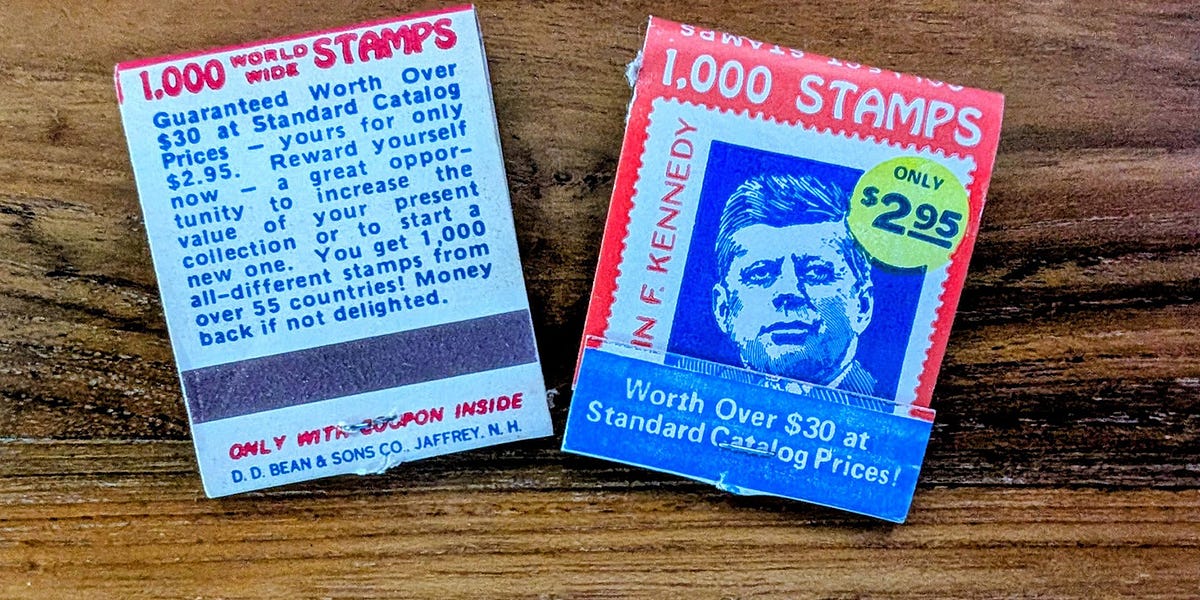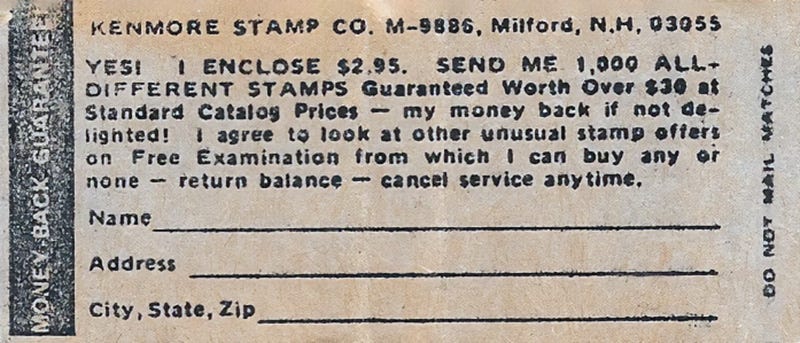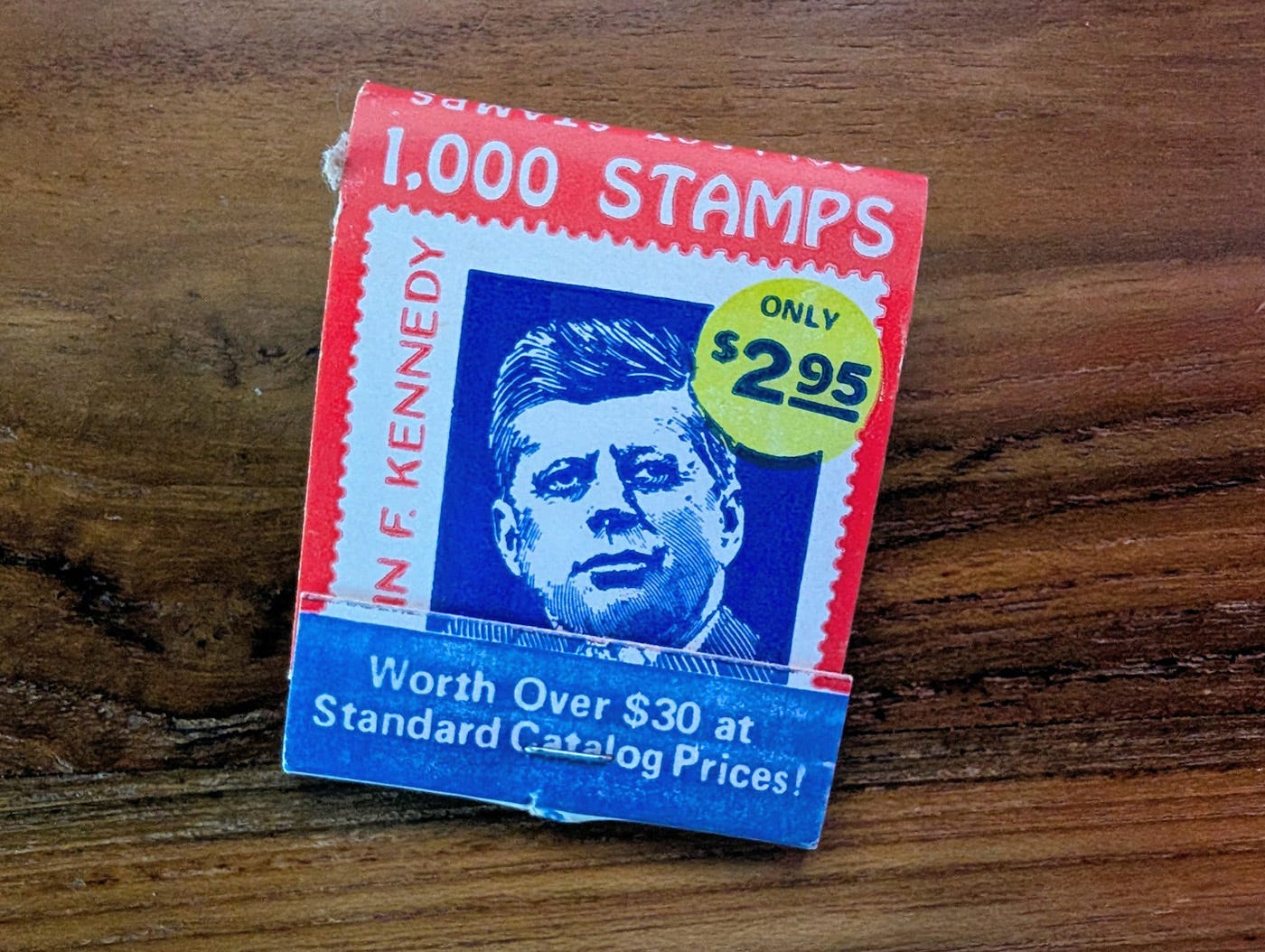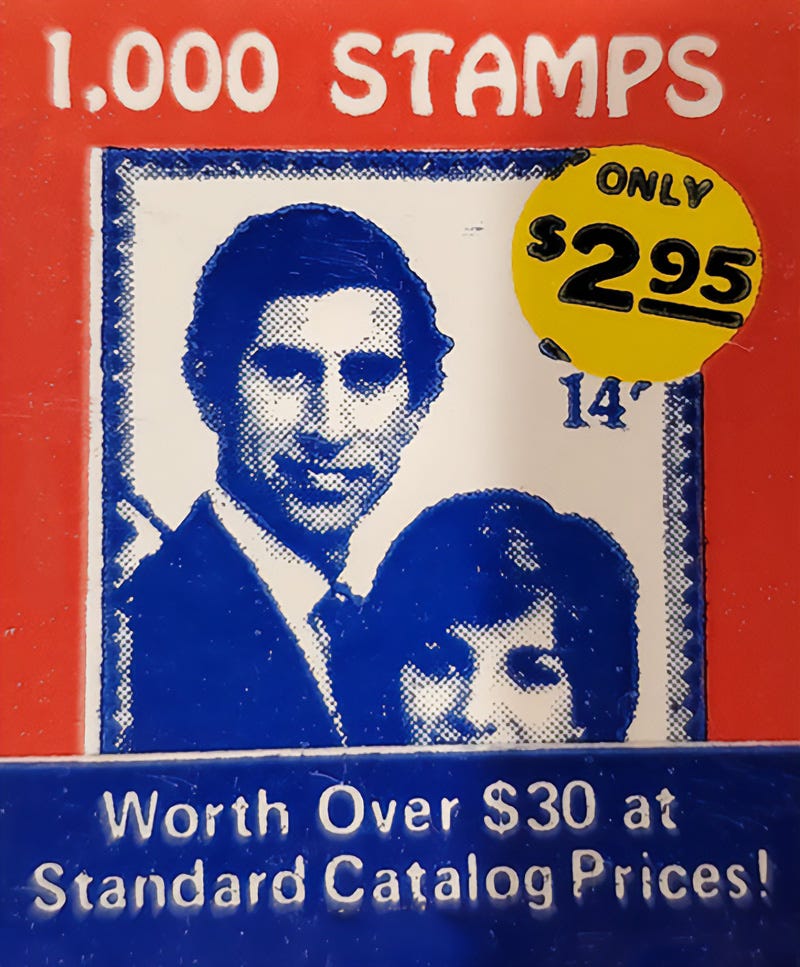
Everyone but me in my family smoked cigarettes. So, pretty early in life one of my chores was to run to the corner store to buy a pack for each member of my family. I did this almost every day. After giving the store owner the money I was given some change, which I usually used to buy candy or play video games, along with a pack of matches. Since almost everyone in my family owned a lighter, these matchbooks piled up. Before long they filled the junk drawer. Over the years we ended up with dozens of different types of matchbooks, but the one I remember most was the 1000 Stamps John F. Kennedy matches.
I never thought much about them, even after handling hundreds of them and dabbling in stamp collecting as a kid. They were just ephemera that slipped into daily life and became part of the background you never questioned. Nowadays though, when I look at them, I want to know the story behind them. Who made them, and what was the deal with all those stamps?
Stamp collecting began in the mid 19th century and by the early 20th century it was one of the most popular hobbies in the United States and Europe. Children were drawn to colorful foreign stamps that could be bought for pennies, while adults and older kids enjoyed the sense of history and geography that stamps represented.
The Great Depression and the war years only strengthened its appeal. It was inexpensive, could be pursued at home, and after World War II the baby boom created a new wave of eager collectors. By the 1950s and 1960s stamp collecting was part of everyday American life, and firms that supplied collectors were eager to find new ways to promote the hobby.
The Kenmore Stamp Company was founded in 1932 by Ernest Greenway Jarvis in Kenmore, New York as a small mail order business built on his personal interest in stamps. In 1943 the business was acquired by H. E. Harris, a leading American stamp dealer. His son later reestablished Kenmore in Arlington, Massachusetts before relocating it to Milford, New Hampshire in 1951. From the mid 20th century onward Kenmore became known for its approval service, where collectors received packets of stamps to keep or return, and for its wide offerings of U.S. and worldwide issues, albums, and accessories. The company advertised heavily to beginners and families through magazines, catalogs, and comic books, but they also saw another promotional tool already in the hands of millions of consumers.
By the mid 20th century matchbook covers were a popular advertising medium because they were cheap to print, easy to distribute in bulk, and often carried around in people’s pockets. Stamp companies picked up on this trend in the 1940s and 1950s, and with smoking so widespread, the idea caught on quickly. You could sell just about anything on a matchbook.
While you might remember the book of stamps, how many of you remember what was inside? It was an order form that that you sent along with your money. My favorite part of the form is the message about not mailing matches. I wonder how often that happened?
In the 1960s Kenmore Stamp Company started using matchbooks as an inexpensive way to promote collecting to the general public. These small ads often featured bold offers such as “1,000 stamps for $2.95” or a free starter set for only a dime, with a money back guarantee. While the covers varied, the one that stood out to me was the one from the early 1980s or late 1970s and featured a notable Argentinian stamp from 1964 with a portrait of John F. Kennedy. So why did Argentina put out a stamp with Kennedy on it?
Argentina issued its John F. Kennedy stamp in 1964 as part of a wave of international tributes following his assassination in 1963. Kennedy was admired worldwide as a symbol of youthful leadership and progressive ideals, and in Latin America he was closely associated with the Alliance for Progress, a U.S. program launched in 1961 to promote economic cooperation and development in the region. By placing his portrait on a commemorative issue, Argentina honored his memory and joined in the global outpouring of respect that followed his death.
Everyone in America knew who Kennedy was, and collecting material related to the president after his assassination was big business even decades later. It was smart for Kenmore to link the hobby to a figure of broad appeal, especially on a stamp that was inexpensive and relatively uncommon in the United States.
While cheap and common at the time, these matchbooks have since become an affordable collectible in their own right. They are valued both as vintage advertising and as an example of how stamp dealers reached a mass audience outside traditional collector circles. This wasn’t the only offer they were running at the time. I remember a Revolutionary War themed one, but probably the more well-known Kenmore matchbook from the early 1980s featured Prince Charles and Lady Diana, tying the stamp hobby to another global cultural moment.
Now I knew that collecting stamps was known as philately, but I didn’t know that collecting matchbooks is known as phillumeny, and during the mid 20th century it was almost as common as stamp collecting. For many people the colorful designs and advertising on match covers were as appealing as the stamps Kenmore was promoting. That overlap helped preserve pieces like the Kennedy and Diana matchbooks, since they ended up not just in the hands of smokers but also in the collections of phillumenists who treated them as worthy of saving (and maybe turned them into philatelists).
For me those matches are not just reminders of who in my family smoked or what was stuffed into the junk drawer. They show how ordinary objects kept bigger stories alive. Kennedy on a stamp printed in Argentina. A company in New Hampshire figuring out how to reach kids like me with a hobby that had already been passed through generations. Even a marriage across the ocean turned into an ad on a matchbook. It all comes together in those little folded covers that were supposed to be used and thrown away, but somehow still survive. In the end, they lit more than cigarettes. They lit hobbies. They lit curiosity. That is why they last.
Trending Products





![NOW Country Classics: 90âs Dance Party[Lemon & Spring Green 2 LP]](https://m.media-amazon.com/images/I/61hVquUofcL._SL500_._SS300_.jpg)





